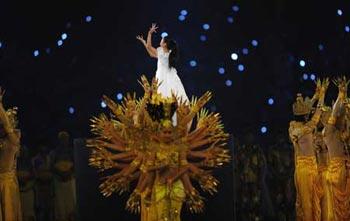Source: Xinhua
09-17-2008 23:05
Special Report: Beijing 2008 Paralympic GamesBEIJING, Sept. 17 (Xinhua) -- An exquisite dance performed by 21 hearing-impaired artists in the Athens Paralympics closing ceremony took the center stage here on Wednesday night as the Beijing Paralympics rang down its curtain.
The Thousand-hand Bodhisattva dance, which as a part of the eight-minute Beijing artistic segment impressed the world four years ago, didn't make it to the opening ceremony of the Beijing Paralympics, to the disappointment of many Chinese.
"We have received a lot appeals from audiences, scholars and artists after the opening ceremony for the return of the dance, saying it would help the world know better about the Chinese disabled people," said Zhang Yimou, general director of the opening and closing ceremonies of the Olympic and Paralympic Games.
 |
| Photo taken on Sept. 17, 2008 shows a scene of the art performance on the Beijing 2008 Paralympic Games closing ceremony in the National Stadium, or the Bird's Nest, Beijing, capital of China. The closing ceremony kicked off at 8 p.m. sharp on Wednesday. (Xinhua/Li Ga) |
Zhang Jigang, Yimou's right hand and artistic director of two Games' ceremonies, is the choreographer of the Thousand-hand Bodhisattva dance.
"So, we listened to their opinions and made some adjustments to make the dance fit for a huge stage like the Bird's Nest (National Stadium)," Zhang Yimou said.
About 90,000 spectators watched the show in an even grander scale as six, instead of one, groups of dancers performed at the center stage.
Guided by sign-language teachers, 126 dancers, all dressed in ornate golden costumes and ornaments, performed in the routine in tribute to an eastern Bodhisattva of compassion. Seen head-on, the arms of the in-line performers moved in synchronicity with amazing precision.
They impressed the world not only with the oriental elegance and peace conveyed by their performance, but also with their consummate dancing skills.
Zhang Jigang was glad at the dance's return.
Bodhisattva, also known as Goddess of Mercy, is often portrayed with a thousand arms, each hand with an eye in it, symbolizing the seeing and reaching out to help those in distress, said Jigang.
"The image of Bodhisattva in the dance represents concept of caring and love, which is absolutely suitable for the gala of the Paralympics," he said.
Editor:Chen Ge
